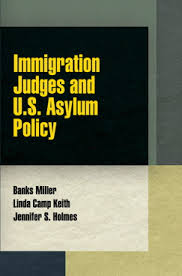What influences asylum decision-making and why is there such variation in the US context? In Immigration Judges and U.S. Asylum Policy, Banks Miller, Linda Camp Keith and Jennifer S. Holmes enhance understanding of how US immigration judges make decisions on asylum applications and the factors that can lead to such disparate outcomes. Anna Matczak welcomes the scholarship as evidencing how asylum decisions are less shaped by human rights commitments than by overarching policy concerns.
Immigration Judges and U.S. Asylum Policy. Banks Miller, Linda Camp Keith and Jennifer S. Holmes. University of Pennsylvania Press. 2015.
 Immigration Judges and U.S. Asylum Policy is about the asylum decision-making process situated in the US context. This scholarship could not be timelier as I came to read it when Europe is experiencing a significant influx of migrants who seek to claim political asylum. The question of whether the migrants are genuinely fleeing persecution or just want to pursue economic opportunities has become a thorny issue and has stirred much debate across European countries. Banks Miller, Linda Camp Keith and Jennifer Holmes painstakingly examine a range of determinants that influence a particular decision-making stage: whether to grant an applicant asylum. I am convinced that the readership will appreciate how interestingly the book delineates asylum as a highly charged political issue that is driven by various policy concerns rather than human rights commitments.
Immigration Judges and U.S. Asylum Policy is about the asylum decision-making process situated in the US context. This scholarship could not be timelier as I came to read it when Europe is experiencing a significant influx of migrants who seek to claim political asylum. The question of whether the migrants are genuinely fleeing persecution or just want to pursue economic opportunities has become a thorny issue and has stirred much debate across European countries. Banks Miller, Linda Camp Keith and Jennifer Holmes painstakingly examine a range of determinants that influence a particular decision-making stage: whether to grant an applicant asylum. I am convinced that the readership will appreciate how interestingly the book delineates asylum as a highly charged political issue that is driven by various policy concerns rather than human rights commitments.
Asylum policy is a component of a broader immigration control policy not only within the United States, but also in many other countries. Nonetheless, the United States accommodates the highest percentage of asylum claims of any receiving country and, for the past three decades, the country has granted asylum to over half a million applicants. Under the circumstances, the authors seek to enhance understandings of why immigration judges (IJs) in the United States do what they do and why there is such variation in the outcome of their decision-making. In so doing, they look into the cognitive approaches to decision-making of IJs in asylum cases to explain this disparity. Although one of the core arguments is that IJs use their policy proclivities (conservative or liberal) to inform their decision-making, the intention of the authors was to go far beyond this claim:
We conceptualized IJs as filtering the ‘facts’ of a case through a perceptual filter, that is, in essence their policy proclivities. Therefore, rather that asserting that IJs use their policy preferences in decision making, we made a more nuanced and theoretically interesting argument: IJs perceive certain facts differently than other facts (189).
Drawing on quantitative rationale for the research, the authors coded a number of facts and classified them as dependent and independent variables. All variables were then gathered in a dataset that comprises every asylum decision decided in the United States between 1990 and 2010. Rigorous statistical analyses were carried out and the results are explained through the lens of three distinctive scholarships: asylum law, international relations and judicial behaviour.
 Image Credit: Courtroom One Gavel (Joe Gratz)
Image Credit: Courtroom One Gavel (Joe Gratz)
As a result, the variation in IJ decision-making is discussed throughout the seven chapters of the book. The introduction is followed by a discussion on methodology and the rationale for the creation of a IJs dataset. In the third chapter, the authors present their data and contextualise them against the aforementioned literatures. One of the chapters is also dedicated to the relationship between asylum applicants, immigration judges and the Board of Immigration Appeals. Chapter Six discusses the key legislative actions taken by the US Congress in the past two decades that are defined as two particular ‘policy shocks’. In the last chapter the authors provide a precise and meticulous summary of their arguments.
The chapter that, in my view, deserves special attention is Chapter Four, which discusses how local economic and demographic conditions may affect IJ decision-making. In this part the following are examined: the local rate of unemployment; the presence of a large concentration of ethnic communities, immigrant-based industries and the ratio of immigrant employment; national immigration salience (measured by the number of stories mentioning immigration per month in USA Today); and the number of registered asylum-related NGOs. According to the authors, these conditions define the extent to which local communities are ‘welcoming for immigrants’ (87), arguing that IJs are quite responsive to these local preconditions. The particularity of this line of argument is that it exposes the local socio-economic realities and public scrutiny of asylum that surround IJs decision-making. From my perspective, this chapter could be used as a frame of reference to understand the responses of EU member states to the current migrant inflow. Undoubtedly, the current refugee crisis has again tested the ‘welcoming’ attitudes of the European countries. Although there have been claims for solidarity, the variety of responses from national governments could also be explained by their somewhat ‘local’ preconditions for the creation of ‘welcoming communities’.
Although this is not part of the data analysis, the book also includes an elaborated section on asylum and terrorism in which the myth about the link between the two is interestingly examined. Security rationales have always been used as a reason for focusing on asylum; however, the authors quote Marisa Cianciarulo, who observes that in the US context, the law ignores the fact that asylum has become more difficult to abuse and has never been a particularly popular avenue for terrorists to pursue (154). For example, at the time of the 9/11 attacks, the asylum system was already a difficult and unattractive means of gaining legal status in the US, and the 9/11 terrorists used non-immigrant visas in order to enter the country (157).
There are only a couple of issues that could be taken into consideration in future analysis. For instance, the impact of court interpreters in asylum hearings is still an under-researched avenue. The authors also argue that top-down control of the US asylum system is all but impossible (194): firstly, because asylum has always been a highly political issue, and secondly, for the reason that decision-making processes occur in disparate local contexts. A certain amount of variation in asylum decision-making proceedings is inevitable, and European leaders should be mindful of this.
Anna Matczak is a Doctoral Researcher at the Department of Sociology at LSE. Her PhD thesis relates to the attitudes of Polish citizens to punishment and justice. Alongside her doctoral studies she has worked as a qualified court and police interpreter in the UK. She tweets @MatczakAnia and blogs about criminology-related topics at www.annamatczak.com.
Note: This review gives the views of the author, and not the position of the LSE Review of Books blog, or of the London School of Economics.






